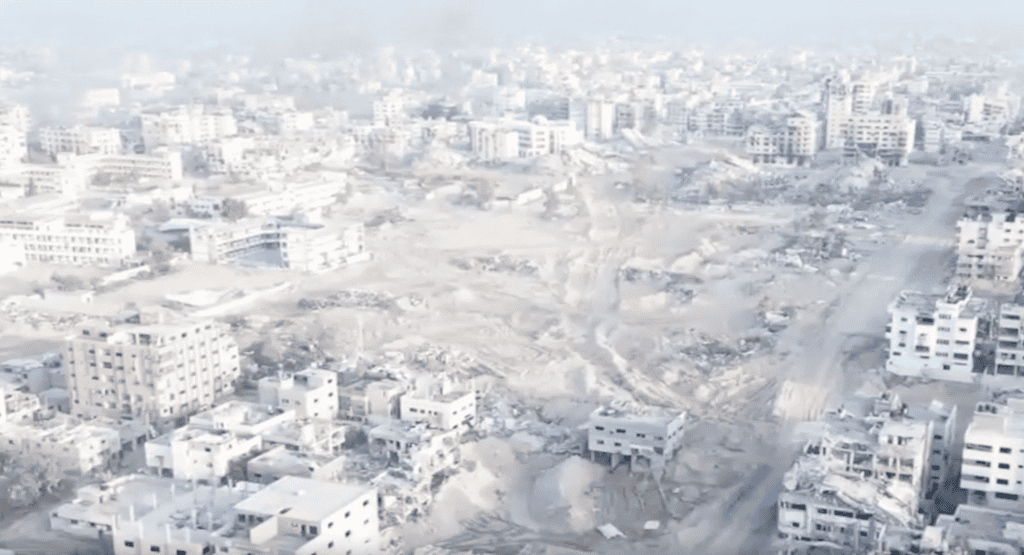
The IDF destroyed a Hamas headquarters in northern Gaza. The command center, which was located within a tunnel network, had electricity and other amenities, illustrating the extensive and sophistication of tunnels underneath Gaza. The IDF said in a statement that the headquarters was linked to an apartment used by Hamas leader Yahya Sinwar.
The unveiling of the apartment and tunnel complex comes as Israel has gained control of swaths of territory in northern Gaza where it has also defeated Hamas battalions. This provides additional opportunity to uncover and further investigate Hamas’ terrorist infrastructure. The December 29 statement on the Sinwar apartment and tunnel complex says that the IDF’s 14th Reserve Brigade was involved in locating and destroying the site. The IDF used its elite Yahalom combat engineers to examine the apartment and uncover a tunnel shaft. “The soldiers inspected the tunnel shaft and reached a significant tunnel that is apparently used by the senior officials of Hamas’ military and political wing,” the IDF said.
Footage released by the IDF showed the investigation of the tunnels. An infographic also shows how the tunnels branch out to civilian homes. The tunnels were 60 feet deep, and they had their own sewage so people could live in them for extended periods of time. “The tunnel was built so that it would be possible to stay inside it and conduct combat from it for long periods of time,” the IDF said in a statement. Footage of the tunnel complex being destroyed also shows that it was near the Mediterranean Sea, north of the port of Gaza.
In southern Gaza, the IDF also continued to expand operations. It had already expanded operations this week from Khan Yunis to areas in central Gaza around Al Bureij. It has now moved into Gazan villages near the Israeli border between Khan Yunis and Israel. These areas were left unsecured during the rapid dash by the IDF’s 98th Division into Khan Yunis in early December which included paratroopers and commandos backed by tanks. Elements of the IDF 5th Brigade under the Gaza Division are now operating in Khirbat Ikhza’a which is on the border with Israel. The IDF said this is the point from where Hamas terrorists embarked on their October 7 attack in Israel. The IDF also committed soldiers from the Kfir Brigade to support existing operations in Khan Yunis.
On the humanitarian front in Gaza, Israel also sought to highlight the transfer of medical supplies into Gaza. Since the war began, around 1.5 million people in Gaza have been displaced by fighting, and humanitarian concerns have been at the forefront of discussions at the UN. In addition, countries in the region have sent support for field hospitals, such as Jordan conducting air drops and the UAE supplying a hospital via Egypt.
Israel’s Coordination of Government Activities in the Territories (COGAT) said on December 29 that 49,000 doses of various vaccines have been transported into Gaza. The transfer was coordinated with UNICEF (the United Nations Children’s Fund), COGAT said. “The residents of the Gaza Strip will receive the vaccinations from UN aid organizations and international medical organizations, who are operating in coordination with Israel as part of the humanitarian effort on behalf of the Gaza Strip’s residents,” the statement noted. It also said that an addition 80,000 vaccine doses had been donated by UNICEF and also entered Gaza. These vaccines are against measles, mumps, and rubella, the COGAT statement said.
Israel also responded to an uptick in Hezbollah threats on the northern front from December 25 to 28. The IDF struck a Hezbollah terrorist cell that had launched anti-tank missiles, and Israeli warplanes carried out large strikes against other Hezbollah sites. IDF Spokesperson Rear Admiral Daniel Hagari highlighted the strikes in Lebanon against Hezbollah during an evening briefing on December 29. Sirens sounded in more than a dozen northern Israeli communities throughout the day, due to continued attacks by Hezbollah. In the evening of December 29, sirens also sounded in the Golan near the Syrian border.







